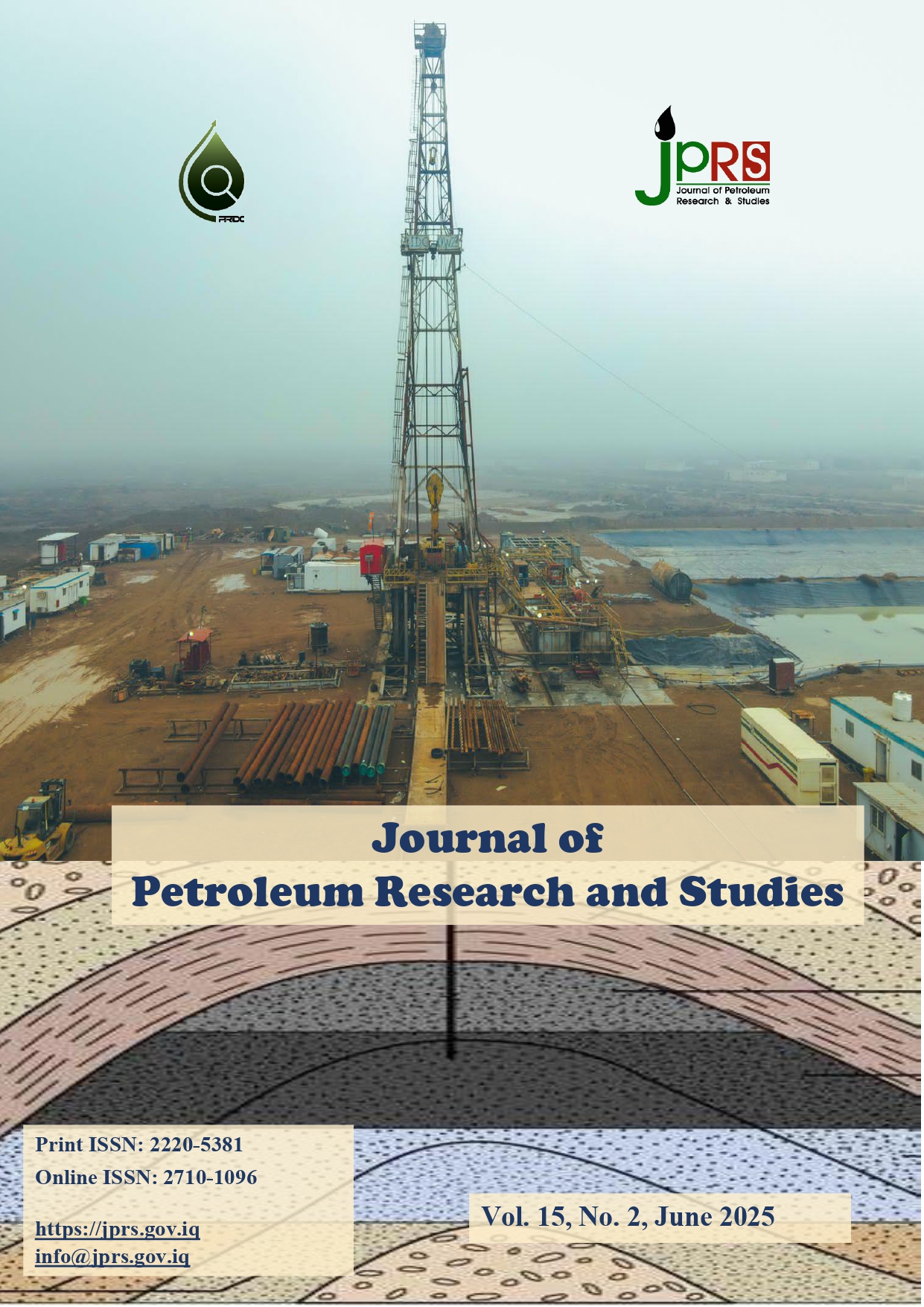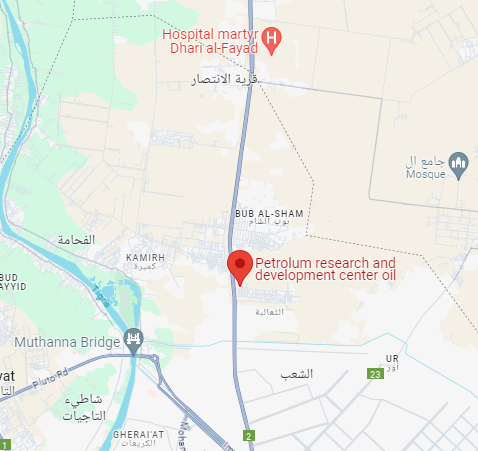The X Formation and its Impact on Tertiary Hydrocarbon Reservoirs in the AX Field, North Iraq
DOI:
https://doi.org/10.52716/jprs.v15i2.922Abstract
The study area (AX Field), located in Salah al-Din Governorate, northeast of Tikrit, alongside the structurally higher HY Field, is an area of significant geological interest, particularly concerning its Tertiary hydrocarbon reservoirs. This study aims to delineate the facies of the X Formation and their lateral extensions across drilled wells, focusing on how the increasing number of anhydrite beds impacts the active hydrocarbon reservoir thickness. Data from well logs (AX-ai, bi, ci, di, ei, fi, gi, and HN-hi), formation tops, and final well reports were utilized to construct geological sections, revealing the stratigraphic continuity and variability within the X Formation. Thickness variations were observed, ranging from 19 meters in AX-ei to 51 meters in AX-ji, indicative of a complex depositional environment influenced by tectonic settings, subsidence rates, and sediment supply for sedimentary basin.
The primary lithology of the X Formation is characterized by limestone and dolomitic limestone, with significant variations in anhydrite content. Wells such as AX-ei and AX-di have fewer anhydrite layers, whereas AX-ji and HN-hi show substantial evaporitic conditions with multiple anhydrite beds. These lithological variations suggest localized geological factors affecting sedimentation and diagenesis processes.
The study concludes that the X Formation is a critical component of the Tertiary reservoir system in the AX Field, serving as both a gas and oil reservoir. The spatial variability in anhydrite lithofacies, increasing northeastward, reflects the complexity of diagenetic processes and sedimentation patterns. Understanding these variations is essential for accurate reservoir characterization and effective hydrocarbon extraction strategies. This research provides valuable insights into the geological and sedimentary dynamics of the AX Field, emphasizing the economic importance thickness and facies of X Formation in the reservoir system.
References
N. K. Al-Azzawi, “Comparative Study of the Tectonic Styles of Folds in Three Areas in the Simple Folded Zone of Iraq”, Unpublished M. Sc. Thesis, University of Mosul, 1982.
M. I. AL-EISA, “The secondary sedimentary cycles for Early Miocene in the oilfields surrounding Kirkuk oilfield, North Iraq, Iraqi” Geological Journal, vol. 25, no. 1, pp. 41–58, 1992.
H. A. Al-Hashimi, and R. M. Amer, “New Tertiary foraminifera species from Iraq”, Journal of Geo. Soc. Iraq, 1986.
A. I. Al-Naemi, “Structural study of Balad Oil Field, and its reservoir indications”, Unpublished M. Sc. Thesis Tikrit university, applied geology department, 2012.
F. A. AL-Sulaiman, and T. A. Ahmed, “Evaluation of tertiary reservoir in Hamrin oil field, North Iraq”, Edelweiss Chemical Science Journal, vol. 4, no. 1, pp. 3–9, 2021. https://doi.org/10.33805/2641-7383.123
T. Buday, “The regional geology of Iraq, stratigraphy and paleogeography”, State Organization for Minerals, Directorate General for Geological Survey and Mineral Investigations, 1980.
R. A. Deabl, A. A. Ramadhan, and A. A. Aldabaj, “Permeability Determination of Tertiary Reservoir/AX Oil Field”, Journal of Engineering, vol. 26, no. 7, pp. 206–216, 2020. https://doi.org/10.31026/j.eng.2020.07.14
R. A. Deabl, A. A. Ramadhan, and A. A. Aldabaj, “Evaluation of Petrophysical Properties Interpretations from Log Interpretation for Tertiary Reservoir/ Ajeel Field”, Iraqi Journal of Oil & Gas Research, vol. 1, no. 1, pp. 28–44, 2021. https://doi.org/10.55699/ijogr.2021.0101.1009
Final well report, “Well AX No. 1, 5, 6, 10, 14, 15, 24, 54, 67”, North Oil Company Lib., Kirkuk, Iraq.
Final well report, “Well Hamrin No. 14”, North Oil Company Lib., Kirkuk, Iraq.
H. Bu, “Chronology of fluctuating sea levels since the Triassic”, Science, vol. 235, no. 4793, pp. 1156-1167, 1987. https://doi.org/10.1126/science.235.4793.1156
North Oil Company, “The geological study of AX field”, North Oil Company archive, unpublished study in Arabic, 1992.
North Oil Company, “The geological study of Mansuriya field”, North Oil Company archive, unpublished study in Arabic, 2004.
N. M. S. Numan, “A plate tectonic scenario for the Phanerozoic succession in Iraq”, Iraqi Geological Journal, vol. 30, no. 2, pp 85-119, 1997.
P. R. Sharland, D. M. Casey, R. B. Davies, M. D. Simmons, and O. E. Sutcliffe, “Arabian Plate Sequence Stratigraphy – revisions to SP2”, GeoArabia, vol. 9, no. 1, pp. 199-214, 2004. https://doi.org/10.2113/geoarabia0901199
R. C. Van Bellen, H. V. Dunnington, R. Wetzel, and D. M. Morton, “Lexique Stratigraphique International center”, Centre National de la Recherche Scientifique, III, Asie, Fasc. 10a, Paris, 333, 1959.
N. A. N. Al-Yassery, and A. A. H. Al-Zaidy, “Depositional and Sratigraphic Evolution of the Early-Middle Miocene Succession in Hamrin, Ajeel and Mansuriya Oil Fields, Central Iraq”, Iraqi Geological Journal, vol. 56, no. 1D, pp. 156-174, 2023. https://doi.org/10.46717/igj.56.1D.13ms-2023-4-22
Downloads
Published
How to Cite
Issue
Section
License
Copyright (c) 2025 Ahmed I. Al-Naemi, Arjan M. Mahdi, Ibrahim A. Hameed

This work is licensed under a Creative Commons Attribution 4.0 International License.














